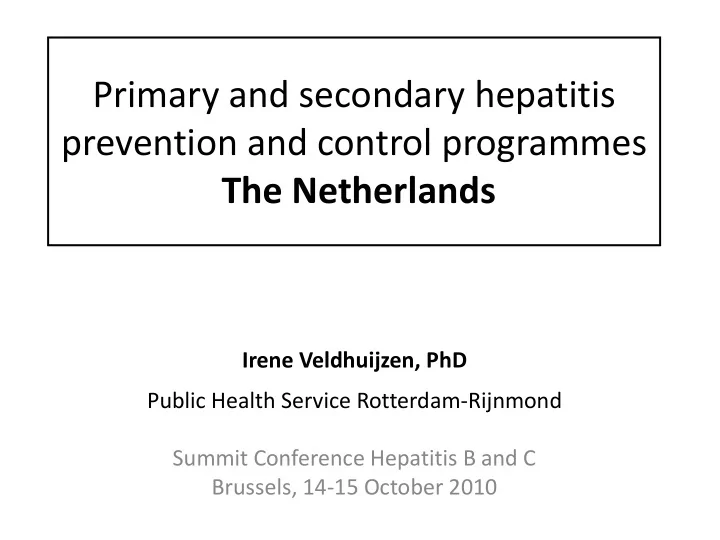

Primary and secondary hepatitis prevention and control programmes The Netherlands Irene Veldhuijzen, PhD Public Health Service Rotterdam-Rijnmond Summit Conference Hepatitis B and C Brussels, 14-15 October 2010
Burden of disease • HBV and HCV notifiable in Public Health Law – HBV: acute and chronic (since 1976) • 250 acute and 1700 chronic cases per year • Acute HBV incidence /100,000 in 2009: 1.2 (men 1.9, women 0.5) – HCV: since 1999 acute+chronic, since 2003 acute only • acute cases per year 34 in 2004 to 52 in 2009 • Prevalence data – HBV 0.1% (Nationwide seroprevalence study, 1996) 0.3% (Pregnancy screening, 2008) 0.4% (Amsterdam N=1300, 2004) – HCV 0.1% (Nationwide seroprevalence study 1996) 0.2% (Regional study N=2200, 2006) Summit Conference Hepatitis B and C, 14-15 October 2010, Brussels 2
Vaccination strategy (1) • National Immunisation programme – Infants from HBsAg+ mothers (since 1989) – Infants with parent(s) from endemic country (since 2003) → 17% of birth cohort – All infants by 2012 • Specific patient groups – Hemophiliacs, dialysis patients, institutionalised mentally handicapped, chronic liver disease • Occupational risk groups – Healthcare workers, dentist, tattooist, acupuncturist, etc. Summit Conference Hepatitis B and C, 14-15 October 2010, Brussels 3
Vaccination strategy (2) • Behavioural risk groups (since 2002) – Drug users – MSM – Sex workers – Heterosexuals STI check-up (up to 2007) Reached through STI clinics, public health services, drug user services, outreach strategies, internet 4
Vaccination strategy Results • Risk groups: 5 year period (2002-2007) 1st vac vaccination coverage estimate MSM 18,510 6% (4 – 7%) DU 13,482 39% (17 – 60%) SW 9,391 25% (19 – 30%) Heterosex 39,297 17% (13 – 21%) Total 80,680 12% (8 – 15%) Reference: van Houdt R et al. Hepatitis B vaccination targeted • Compliance 80% (2 vac), 62% (3 vac) at behavioural risk groups in the Netherlands: does it work? Vaccine 2009;27(27):3530-5. Summit Conference Hepatitis B and C, 14-15 October 2010, Brussels 5
Screening strategy GOALS Hepatitis B: current nationwide programmes • Pregnancy screening – Primary prevention to newborns • Behavioural risk groups – Screening prior to vaccination, identify susceptibles • Contact screening – Vaccination of susceptible contacts – Identification of new HBsAg infections → main reason primary prevention Summit Conference Hepatitis B and C, 14-15 October 2010, Brussels 6
Screening strategy GOALS Hepatitis B → secondary prevention • Screening of migrants for hepatitis B (and C) Regional projects – Chinese (Rotterdam 2009, The Hague 2010) – Turks (Arnhem 2009, Rotterdam 2010) Further implementation of projects for Chinese in other cities (2010) Summit Conference Hepatitis B and C, 14-15 October 2010, Brussels 7
HBV screening campaign Results • Target group: Chinese population in Rotterdam – Outreach campaign: awareness and onsite testing – 1,100 tested (13 activities in 3 months) – 92 HBsAg+ (8.4%) – 35 HBeAg+ or elevated ALT (38% of HBsAg+) – 15 started antiviral treatment (16% of HBsAg+) Summit Conference Hepatitis B and C, 14-15 October 2010, Brussels 8
Screening strategy GOALS Hepatitis C → secondary prevention • Projects for drug users (since 2004) • National Hepatitis C Campaign – Target groups: General population, drug users, migrants – Pilot projects 2007/2008 – 6 month campaign period (Sept 2009-Feb 2010) – Radio, local newspapers, website – Flyers in GP practices, pharmacies, hospitals, drug user serv. – Awareness activities for drug users and migrants Summit Conference Hepatitis B and C, 14-15 October 2010, Brussels 9
National HCV campaign (1) Results • Target group: general public – Website and online risk assessment tool – 80.000 visitors → 16.500 completed risk assessment – GP training and support in 6 largest cities – Increase in HCV testing observed – Mainly in regions with GP support (+26%) – Increase in percentage test positive – Highest in GP support regions (5.8%, +16%) Summit Conference Hepatitis B and C, 14-15 October 2010, Brussels 10
National HCV campaign (2) Results • Target group: drug users – 715 screened → 176 (25%) HCV positive – 35% of positives (n=62) started treatment (by May 2010) Summit Conference Hepatitis B and C, 14-15 October 2010, Brussels 11
Treatment strategies • Guideline for referral from primary to secondary care • Dutch treatment guidelines (2008) • Treatment covered by health insurance Summit Conference Hepatitis B and C, 14-15 October 2010, Brussels 12
Screening strategy Lessons learnt • Ensure referral to secondary care • Enhance existing programmes – Pregnant women → refer to specialist before third trimester • HCV campaign increased testing through GP’s • Migrants can be reached with outreach campaigns Summit Conference Hepatitis B and C, 14-15 October 2010, Brussels 13
Screening strategy Challenges (1) • Combine hepatitis B and C screening • Expand to all migrants from endemic area’s • Upgrade from local projects to nationwide level • From projects to structural approach • Funding • Define best screening practices Summit Conference Hepatitis B and C, 14-15 October 2010, Brussels 14
Screening strategy Challenges (2) • Need for data to support policy making! − Compliance to screening criteria ( Wilson&Jungner) Potential harms and benefits − Impact of various alternative screening strategies e.g. systematic, opportunistic, outreach − Cost effectiveness evaluation → long term clinical follow up data needed Summit Conference Hepatitis B and C, 14-15 October 2010, Brussels 15
Recommend
More recommend